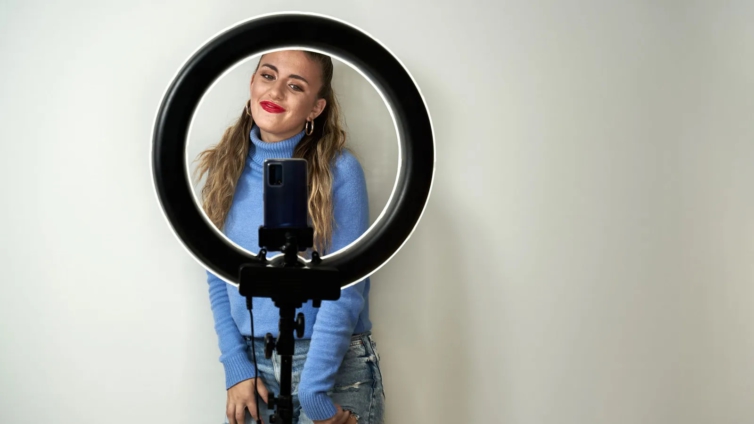Shola West, 22, works on the media-partnerships team at advertising firm OMD. She combines her full-time role with a part-time business: providing Gen Z career advice through freelance consultancy work.
West, who is based in London, says her employer is aware – and supportive – of her side hustle. “At my interview, they made it clear I was welcome to have my personal brand on the side. My CEO recently commented on my LinkedIn post saying what I’d done was brilliant, even though it had nothing to do with my full-time job,” she says. “Their openness means it doesn’t feel like a 9-to-5: it’s a job that works with my passions.”
Flexible work arrangements have also enabled West to pursue other passion projects. During working hours, she creates content for her TikTok account, offering insights into the media industry. “Hybrid working has complemented my side hustles,” she says. “It’s when I’m at home in between meetings that I can film videos or work on my business.”
West is one of many young workers who believe a full-time role alone isn’t enough for a fulfilling career. Generational shifts, an uncertain economy and a dynamic workplace situation mean the typical career of a young worker today looks very different than years ago, pre-pandemic.
Gen Z is moving into the workforce in significant numbers: Bureau of Labor Statistics (BLS) data shows there were 21 million employees aged 16 to 24 in the US by July 2022, with the employment rate rising 54.4% year-on-year. And as they age in, the side hustle will likely grow in popularity and acceptance. Over time, pursuing passion projects and multiple streams of income may well prove to be one of the most significant differentiating factors of the youngest generation in the workforce.
The rise of the hustle
Side hustles existed before the pandemic, but they were often borne from a place of necessity rather than passion. In the past several years, they’ve come in the form of gig-economy jobs, either in lieu of a full-time role, or as a means of supplementing wages.
Even now, side hustles are necessary to supplement income for many people: one September 2022 survey of 4,000 UK workers, from insurance company Royal London, shows 16% of respondents had taken on an additional role to help pay for cost of living increases.

“The stacking of jobs has always existed, but it’s usually been done by workers who’ve needed to as a means of economic survival,” explains Meredith Meyer Grelli, assistant teaching professor of entrepreneurship at Carnegie Mellon University's Tepper School of Business, based in Pittsburgh, US.
While the layering of jobs will continue to be the reality for sections of the workforce, the changed world of work has meant a new kind of side hustle has emerged for knowledge workers. Adopting flexible working patterns, employees have a greater opportunity to pursue passion projects and make extra money through choice rather than necessity.
“Without full-time office settings, there’s less visibility on the worker,” says Caroline Frankum, CEO of consulting firm Kantar’s Profiles division, based in London. “Working hours have also become less fixed and regimented, while commuting times have reduced – it’s enabled more people to do more side hustles.”
The result is that a second source of income has become desirable even for employees in well-paid full-time roles. “Following the pandemic, side hustles have appealed to a different level of worker and expertise,” says Meyer Grelli. “These workers are higher up the job value chain: they can now figure out how to combine roles and side projects in their lives as a way of maximising income against their skills.”
The rise of online platforms like Shopify and Etsy that allow workers to easily monetise hobbies, and social media accounts customised for personal branding, is a main driver. “The model that’s been used by workers layering jobs out of necessity has created a pathway for those in higher-earning jobs to adopt themselves,” says Meyer Grelli.
The Gen Z twist on the side hustle
While more employees are pursuing side hustles, the trend is being led by those just beginning their careers. A February 2023 global survey of 10,000 workers by Kantar shows that 40% of Gen Z workers are combining at least two roles.

Some of this is still being driven by financial considerations, amid economic uncertainty and the rising cost of living. “We have a constant awareness that you need more than a nine-to-five to make money,” says West. “We’re told on social media that we need seven sources of income.”
However, broader generational shifts also make side hustles more appealing to Gen Z. “Career paths are becoming less linear,” says Caitlin Duffy, director of research at consulting firm Gartner, based in Virginia, US. “Young workers are entering a turbulent work environment: they want to set themselves up for long-term employability, remain flexible and be able to move between workplaces, rather than necessarily stay in one job longer term.”
Side hustles also diversify risk, says Meyer Grelli. “Younger workers are aware that roles and industries can become obsolete at a dizzying pace. The careers of their parents’ generation are no longer necessarily stable options, so they instead often look to their peers, who are innovating new pathways through experimental side hustles, amplified on digital platforms.”
The versatility that side hustles provide are also key to Gen Z. “Among students I work with, there’s a perceived inflexibility to a traditional career: one told me they’d never give their ‘whole self’ to work,” says Meyer Grelli. “Instead, they want to construct a pathway that’s spread more evenly around their lives. They’re entering the workforce at a time where everything is in flux, so they’ve grown up with flexibility.”
As well as opening new sources of income, side hustles also allow young workers to invest in their passions. “Work is a source of identity for many,” says Meyer Grelli. “Passion projects mean those at the beginning of their careers can explore and test interests and ideas beyond the dominant pathway of their career trajectory – they serve as a way for young people to find value.”
At its best, a side hustle offers young workers both personal and financial growth. Meyer Grelli says a student of hers is working on a start-up that creates a platform for digital natives to work multiple tech jobs at once, based on their own schedule. “It’s been inspired by his own experience over the past few years: being able to pick up a number of digital projects that can be done from anywhere, and overlap them in his life at the same time.”

A future hallmark
In the new world of work, there are signs that employers are already becoming more accepting of employee side hustles. “Before the pandemic, workers were less open and willing to talk about anything that could potentially divert energy away from their full-time job, even childcare,” says Meyer Grelli. “But now, businesses are more empathetic and receptive to the deeper needs and wants of their workers – and that includes passion projects.”
Not only could side hustles serve as a retention tool for employers, they can also enable employees to accrue experience and deepen skill sets that are invested straight back into their day job. “A young worker now will have a long career in which they’ll expect to evolve and side hustle,” says Meyer Grelli. “It falls on employers to figure out how to incorporate that into their own growth, rather than avoid or stifle that.”
In her full-time role, West has recently been promoted as a Gen Z engagement executive – a point of contact for clients looking to reach Gen Z audiences – due in part to her personal brand and freelance work. She believes that side hustles will become more commonplace – and increasingly welcomed by employers.
“We’re a multifaceted generation: my boyfriend is an accountant and has a sneaker page on Instagram; a friend works in nursing but does photography,” adds West. “Employers that embrace this means they’ll have young workers able to bring their authentic selves to work every day, while providing more skills and clout to the business.”
When done right, a side hustle can be fulfilling, providing workers a variety of experiences, skill sets and sources of income that heighten their career achievements. The caveat is that it could lead to overworking – but West says her 50-hour workweeks are worth it. “I'm passionate about my side hustles so it feels more like fun than 'work'. Plus, I know it will benefit my future, so I'm willing to put the work in.”
As more of Gen Z enter the workforce, side hustles are likely to become more normalised – and perhaps will one day be a workplace expectation.
“There has been a fundamental shift in what a career looks like since the pandemic, particularly among younger workers,” says Frankum. “What motivates and drives young workers is often doing multiple things, being more purposeful in the workplace and continuing to learn – all of which can be achieved through a side hustle.”
Latest Stories
-
Sustainable Finance: How banks are driving SDG Goals
14 mins -
Guinness Ghana DJ Awards 2024: MC Portfolio nominated as Best MC/Hype man
18 mins -
MFWA holds Peace Dialogue for Youth in the Volta Region
27 mins -
Galamsey fight: Kofi Koranteng wants jail time for Akufo-Addo and ministers over ‘gross incompetence’
31 mins -
FirstBank Ghana joins Global Cybersecurity Awareness Month Initiative
34 mins -
NPP MPs ask Bagbin to recall Parliament after indefinite adjournment
41 mins -
Alan Kyerematen backs calls for forensic audit of Voters Register
46 mins -
G7 Security Systems donates to Hope Training Institute
56 mins -
I would like to feature 50 Cent on remix of ‘Unsinkable’ – Shortman
1 hour -
NSMQ24: TAMASCO stages stunning comeback; beats St John’s School, Accra Academy to secure semi-final slot
1 hour -
Missy Elliott, Queen Latifah first rappers awarded with National Medals of Arts and Humanities
1 hour -
Akufo-Addo to cut sod for construction of Manganese Refinery as gov’t’s value addition drive deepens
2 hours -
EFL criticises NDC’s inaction, calls for recall of Parliament to impeach Akufo-Addo
2 hours -
Springfield Group denies submitting contradictory data to government; demands apology from ACEP
2 hours -
Joe Mettle girds up for ‘Sing Over Ghana’ prayer event
2 hours

